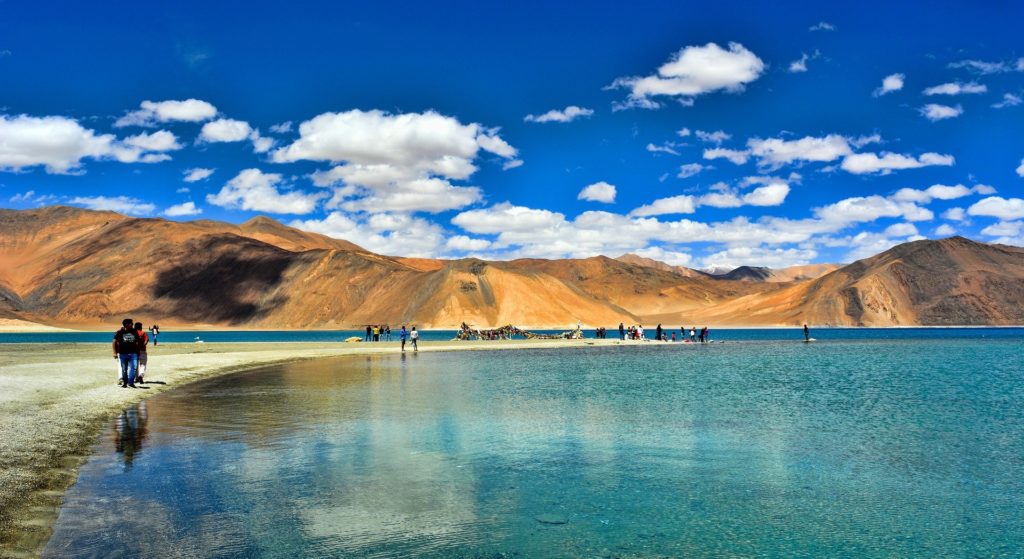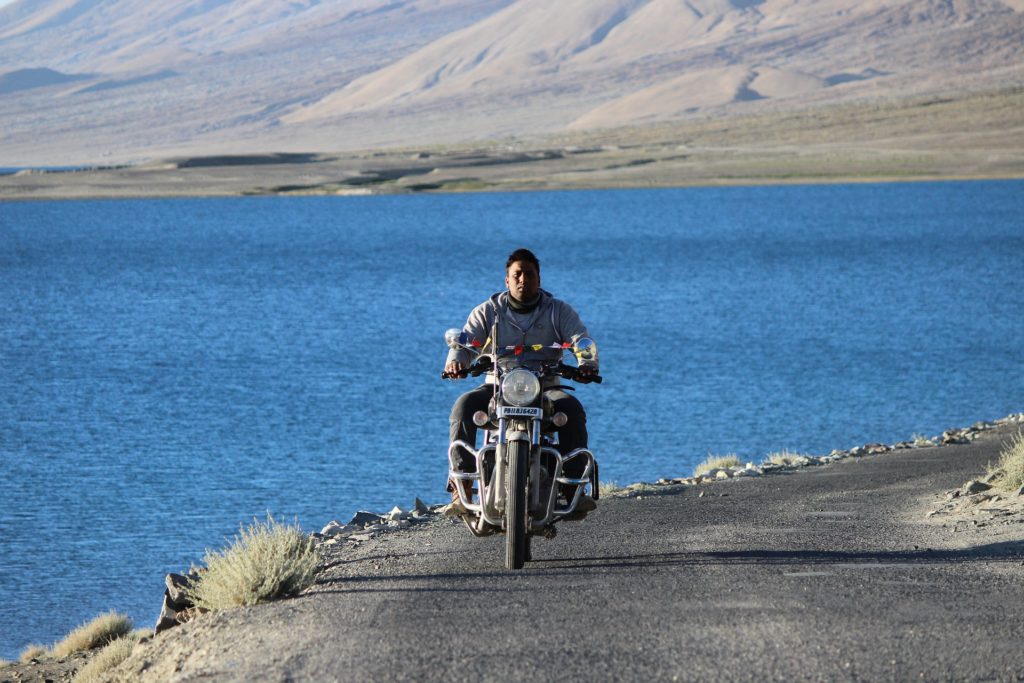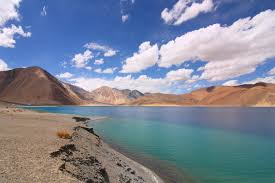The Pangong lake, also known as the Pangong Tso, is cradled in the Changthang region of Ladakh. Especially after the release of Bollywood’s blockbuster movie, “3 Idiots” Pangong Lake has become one of the most wanted to visit places in India. It is a very beautiful, ocean-like, saltwater lake which is about 134km long (60% of its length is extended to Tibet) and 5km wide at its widest point. People usually prefer to visit this site during summers, but this pristine lake, when completely frozen during winters, also conducts an exhilarating tourist point due to its aqua blue hue.
Sitting in front of the television when you watch movies with this lake and its surroundings in the background, you might feel like it’s the most romantic place on earth. But when you get an insight into the reality and get to know about the place, you’ll find its rough terrain and harsh climate really difficult to survive especially, during winters.
HOW TO VISIT PANGONG LAKE?
First of all, to visit the lake, you would have to get an Inner Line Permit, which is compulsory for both Indians and foreigners as it lies near the Line of Actual Control. When it comes to infrastructure and other facilities, there is only a couple of cemented accommodation around the lake.
There’s not much luxury, but one would feel lucky to find some basic facilities like electricity, hot running water, medical aid, western toilets, etc.
People who have a problem getting acclimatized to higher Leh altitude and have experienced acute mountain sickness before should be careful as there is a lack of oxygen.
You need to do prior planning and make arrangements accordingly because it is a high altitude region. If you are going along with a travel guide, then he/she will make you aware of how to visit Pangong lake and make arrangements for the same.
READ ALSO: Best Campground in US
Location
If you are traveling from the town of Leh, then the Leh to Pangong lake distance by road is about 222kms. Pangong Tso lake is situated in the Ladakh district of Jammu and Kashmir.
If you are planning on a trip to the Pangong from Leh, you might at least need one day as it would take almost 6 hours to reach there, or you could even plan a two-day trip.
Altitude
Pangong, Leh elevation is at a staggering altitude of 4350meters or 14270feet. It is one amongst the highest altitude lakes of the Indian Himalayas and also the biggest of all lakes in Leh, Ladakh.
ALSO READ: World’s Best Nude Beaches to Visit Once in a Lifetime.
Best time to visit the Pangong Tso Lake

Generally, due to the Ladakh altitude, the peak season is during summers; hence the best time to visit the lake would be in the summer months when it would be in full flow.
As we have mentioned earlier, during winters, the lake is completely frozen, i.e., from January-March. If you tend to stay there at that time, you would have to book for some homestay in Spangmik or Man-Merak village to be around the lake.
April could also be one of the best months to visit the lake because, during that month, the lake starts to melt from the serene white icy state and converts into the beautiful hues of blue. And if you’re planning to go there during the peak tourist season, then you may want to plan your trip between the months of May and September.
You would find the lake flocking with tourists at its bay who have come to spend their summer or monsoon vacations in the beautiful lands of Ladakh.
Along with humans, you would also see birds flocking around the lake, including the Brahmini Ducks and the Bar-headed Goose.
Talking about the best time, it is certainly between the later weeks of September and the early weeks of October.
It would certainly be the best time because then mostly the tourists start leaving, the place is less crowded, the lake is at its utter beauty, and you get amazing deals.
Pangong Lake during winters
The Pangong temperature during the wintery months of October-February is a freezing -5 degree celsius to 10 degrees celsius.
Due to the freezing cold, most tourists tend to pack up after December, and if you visit the lake after that, then you would find homestays with basic facilities around there or some guest house in Tangste, which is about 34kms away from Pangong.
At Tangste, you would find a place with much better facilities and suitable conditions to find comfort during winters. While you are staying in Tangste you could go visit the lake on a sunny day, but it is good to check the weather forecast before leaving Leh.
HOW TO VISIT PANGONG LAKE?: THE ROUTES
When you plan a trip especially, road trips, you have to keep in mind to pre-plan the entire trip by looking for all the different routes.
Tracking routes beforehand would help you know the shortest one and also the easiest one.
There are different routes to reach the Pangong Lake from both Nubra Valley and Leh town. You can either travel by road via Karu-Chang La Pass from Leh or Shyok Village route and Wari La Pass route from Nubra Valley.
Route from Leh to Pangong Lake
Well, if you take the Karu-Chang La Pass route to reach the lake by road, you will have to travel 170km. This is the route mostly preferred by everyone to reach Pangong Tso. Depending on the breaks you take between the journey, you will take around 5-6 hours to the most to reach the lake.
While driving through this route, you will be able to cover Thiksey, Hemis, and Shey Monasteries. It is better to take a two day trip to the lake from Leh if you want to have a relaxing trip.
You should acclimatize your body before leaving for Pangong Tso by staying a few days and nights in both Leh and Nubra Valley. In case you are short on time, then this is the best and fastest route, comparatively, to reach the lake.
ALSO READ: Best Black Beaches You Must Visit.
Route from Nubra Valley to Pangong Lake Ladakh
This route can also be taken to reach Pangong Lake if you are in Nubra Valley and have no time to go back to Leh. Also, if you don’t want to miss a picturesque sunset or sunrise at the Pangong Tso lake, then you might want to take one of these two routes:
Nubra Valley-Wari La-Pangong Tso
Wari La Pass, one of the remotest passes of the Ladakh region, would take you to the lake. This long and rough route takes around 11-12 hours to get to the lake depending on the interim breaks you take so, it is better to leave early in the morning to reach before the sunset.
While taking this route, it is better to check the conditions at Agham Village and be careful and equipped because it is a remote region where you would neither find any cars or people to help you in case of any emergency.
If you have a permit for Nubra Valley and Pangong Tso, you do not require any other permit or pass to travel via this route. The route, subsequent places, and the distances are as follows-
Diskit – Khalsar(19kms) – Agham(31kms) – Tangyar(11kms) – Wari La(28kms) – Tathok(25kms) – Sakti(4kms) – Chang La(34kms) – Durbuk(32kms) – Tangste(9kms) – Lukung(34kms) – Spangmik(16kms) = 243km
NOTE:
Do not take this route in the early season as, at that time, the road is not much stable and also is low on priority for BRO.
It is better to carry fuel with you from Leh to cover around 425-475kms because mostly the Deksit petrol pump in the Nubra Valley is out of fuel, though, from 2006, the fuel availability has been much better.
In case you don’t find fuel there and have no spare with you, then it will be hard to cover Leh – Nubra Valley – Wari La – Pangong Tso – Leh route without any other petrol pump.
Nubra Valley to the Ladakh lake, Pangong via Shyok Village
The route which takes you to Pangong Tso from Nubra Valley via Shyok village became quite popular among tourists from 2019 as it is shorter than the Wari La Pass route. It just takes 6-7 hours to reach the lake via this route, but you have to be careful while passing through a couple of nasty water crossings and the landslide-prone stretches.
So, before leaving Nubra early in the morning, make sure the conditions at Agham Village are favorable, and if you don’t have much company, it’s better to tag along with other travelers using that route.
You don’t require any special permit for this route if you have the permit for Nubra and Pangong Tso. The route, subsequent places, and the distances are as follows –
Diskit – Khalsar(19km) – Agham(31kms) – Shyok Village(48kms) – Durbuk(18kms) – Tangste(9kms) – Lukung(34kms) – Spangmik(16kms) = 175kms
NOTE:
Try to make sure that you carry fuel from Leh to cover distances as much as 350-400kms because fuel may or may not be available at the Diskit petrol pump, and there are no fuel stations on the entire route except for the one at Diskit.
The route from Tso Moriri Lake
As there is also a route from Tso Moriri Lake to Pangong Tso, people tend to take it often so that they can leave Ladakh from Tso Moriri using the Manali Leh Highway after visiting the Pangong without having to return back to Leh.
Also, the Ladakh height at Tso Moriri is higher in altitude in comparison to Pangong Tso. If you want to pass through beauty and nature’s imagery, then you might want to take the remote route via the Changthang region to reach Pangong from Tso Moriri.
You would be crossing the most beautiful route in the entire Ladakh region while driving between Pangong Tso and Tso Moriri. Do not forget to take a special permit from Leh DC office because you need it before crossing Chusul to travel on this route.
In the end, to acclimatize your body stay at Pangong before spending a night at Tso Moriri. The route, subsequent places, and the distances are as follows –
Tso Moriri (Korzok) – Sumdo(53kms) – Mahe(10kms) – Nyoma(25kms) – Loma(22kms) – Tsaga Village(23kms) – Tsaga La(20kms) – Chusul(33kms) – Kakstet(24kms) – Merak(4kms) – Man(12kms) – Spangmik(9kms) = 235kms
NOTE:
It is unlikely for you to follow the route in the aforementioned manner but still if you manage to do so then, carry spare fuel from either Leh, Upshi or Karu to cover about 600-700kms because in the entire route between Leh – Tso Moriri – Nyoma – Loma – Pangong Tso – Leh you would not find any other fuel stations.
ROAD CONDITIONS AND PREFERED VEHICLES

Leh height from sea level is 3,500m, you would definitely require a higher ground clearance vehicle. Depending on driving skills and prevalent road conditions, people also make the journey in sedans and hatchbacks. 4X4 are preferable to drive between Nubra Valley – Shyok Village – Pangong Tso route and also between the Tso Moriri and Pangong Tso route.
The road from Leh to Pangong via Karu Chang La route is good enough for actually any type of car, including sedans and hatches.
AN OFTEN FOLLOWED ITINERARY
If you have planned to visit the Pangong Tso lake, then it is a must to at least stay for a night to be able to witness all the beautiful imageries created by and around this lake during sunrise and sunset.
This blue-colored saltwater lake would charm you from head-to-toe only if you are up to enjoy it lavishly without being in a rush to leave. What most people generally tend to follow is this itinerary –
Day 1 ~ Leh town– Hemis Monastery – Pangong Lake
- You would get to cover all or at least either of the Hemis, Shey, or Thicksey while going to the Pangong Tso.
- A night’s stay at Spangmik or Lukung near Pangong Tso Lake.
Day 2 ~ Pangong – Thicksey – Leh town
- While returning back to Leh cover whichever of the either you missed on day one from Hemis, Shey or Thicksey.
- An overnight stay in the town of Leh.
WHERE TO STAY?
As the shore of the very Pangong Tso Lake falls under the Ramsar Site Wetland Reserve, you cannot camp on the shore or anywhere near the lake. So, you would either have to camp somewhere else or find a guesthouse or hotel to spend the night.
Since 2018, Leh DC has issued a ruling which asks all the camp stays and hotels at Pangong to vacate, which are illegally established. Hence, before making any deal or booking, make sure to confirm the same from your hotel or camp folks.
You could easily find someplace to stay near the lake but outside the reserve area by searching online or contact a travel agent.
In case you are traveling with a group under some trek organizers, make sure they are arranging for your stay so that you could make prior bookings for yourself.
MEDICAL FACILITIES
If you fear to suffer from acute mountain sickness, do carry your own oxygen cylinder while traveling. Otherwise, you could avail the same and other first-aid medical facilities at Tangste Village, which is about 34kms from Lukung Village and 50kms from the Spangmik Village. Some tents and camps also tend to have first aid and oxygen availability.
WHERE TO FIND FOOD AND WATER?
If you have booked a vacation package under some trek organizers, they tend to carry or at least arrange for your food and water. Otherwise, you could eat from your homestay at Spangmik Village. Being in a remote area, you will have to manage for food and water from roadside shacks, camping sites, or homestays.
If you’re wandering on your own by your own vehicle, you could carry canned food items like canned cheese, beans, cherry tomatoes, frozen fruits, vegetables, meat, etc. and jerry cans filled with water. If you are planning to cook intents, you will also have to carry a portable stove and gas cylinder.
NOTE:
Make sure that you collect all the waste at a time and dispose of it off in a garbage bin or dumping area so that you are not polluting the lakes, plains, and valleys. Do not pollute the Himalayas!
MOBILE CONNECTIVITY AND ATM’S
When you plan to go far off in the lap of the Himalayas, you are actually seeking riddance from people and its modern civilization. Hence, you will not find any mobile network while at the Pangong Tso Lake. If you want to get some connectivity, at least in Ladakh, you will have to carry an MTNL or BSNL postpaid connection. Also, since 2018, there is a BSNL tower set up at Lukung, which may or may not work whatsoever.
You will not find any ATM near the Pangong, and people don’t usually have card swiping machines as well so, it is better to carry cash according to your itinerary. Also, make sure to pack essentials for your road trip to avoid problems.




